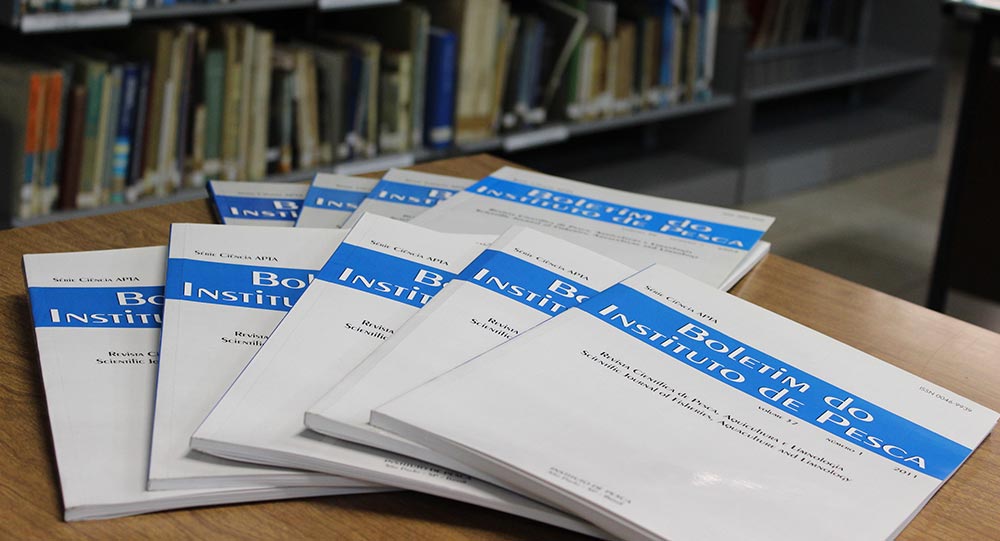Pesca no Arquipélago de São Pedro e São Paulo: 13 anos de monitoramento
Palavras-chave:
Acanthocybium solandri, captura-por-unidade-de-esforço, Cheilopogon cyanopterus, Elagatis bipinnulata, Thunnus albacaresResumo
O objetivo do presente trabalho foi verificar a variação temporal da composição específica dos peixes pelágicos capturados pela frota comercial e a captura-por-unidade-de-esforço (CPUE) das principais espécies capturadas no Arquipélago de São Pedro e São Paulo (ASPSP). Dados de seis barcos baseados em Natal í RN, que operaram no ASPSP entre 1998 e 2010, foram monitorados, com um total de 290 desembarques. A albacora-laje (Thunnus albacares) foi a principal espécie capturada, com a CPUE permanecendo relativamente estável durante os anos. A variação mensal da CPUE da albacora-laje mostrou um grande aumento do seu valor entre os meses de novembro e março, indicando maior abundí¢ncia desta espécie durante este período. A cavala-impingem (Acanthocybium solandri) também apresentou CPUE estável ao longo dos anos, com aumento do seu valor entre os meses de julho e setembro. A CPUE do peixe-rei (Elagatis bipinnulata) também permaneceu estável ao longo dos anos, apresentando aumento no verão, entre outubro e dezembro. A CPUE do voador-holandês apresentou declínio durante os últimos anos de monitoramento e a CPUE mensal teve valores baixos de junho a novembro e valores elevados nos meses restantes, com picos em dezembro e abril. As variações da CPUE observadas nas espécies monitoradas são discutidas ao longo do texto.
Referências
Cahiers ORSTOM. Série Océanographie, 15(4):389-419.
ANDRADE, H.A.; TOZETTO, A.L.; SANTOS, J.A.T.2005 The effect of environmental factors and of
the fishermen strategy on the skipjack tuna(Katsuwonus pelamis) CPUE in the Southwest
Atlantic. Collective Volume of Scientific Papers ICCAT, 58(1): 350-358.
BRí–ECKEL, K. V. and MEYERHí–FER, M. 1999 Impact of the Rocks of São Pedro and São Paulo
upon the quantity and quality of suspended particulate organic matter. Archive of Fishery and
Marine Research, 47(2/3): 223-238.
COELHO, R.; NIKOLIC, N.; EVANO, H.; MIGUEL,N.; BOURJEA, J. 2014 Reunion island pelagic
longline fishery characterization and standardization of albacore catch rates. Indian Ocean Tuna Commission, 1-36.
HAZIN, F.H.V. 1993 Fisheries oceanographical study on tuna, billfishes and sharks in the southwestern equatorial Atlantic Ocean. Tokyo. 286p. (Tese de Doutorado, Tokyo University of Fisheries).
ICCAT 2011 Report of the 2011 ICCAT yellowfin tunastock assessment session. San Sebastián, Spain -September 5 to 12, 2011. 113p. [on line]: URL:<http://www.iccat.int/Documents/Meetings/
Docs/2011_YFT_ASSESS_REP.pdf>.
LUBBOCK, R. and EDWARDS, A. 1981 The fishes of
Saint Paul's rocks. Journal of Fish Biology, 18(2):
135-157.
LESSA, R.P.T.; MAFALDA-JR., P.; ADVINCULA, R.;LUCCHESI, R.B.; BEZERRA-JR., J.L.; VASKEJR., T.; HELLEBRANDT, D. 1999 Distribution and abundance of ichthyoneuston at seamounts
and islands off North-Eastern Brazil. Archive of Fishery and Marine Research, 47: 239-252.
MAURY, O.; GASCUEL, D.; MARSAC, F.;FONTENEAU, A.; ROSA, A.L.D. 2001 Hierarchical interpretation of nonlinear relationships linking yellowfin tuna (Thunnus albacares) distribution to the environment in the Atlantic Ocean. Canadian Journal of Fisheries and Aquatic Sciences, 58(3): 458-469.
MPA - MINISTÉRIO DA PESCA E AQUICULTURA. 2011 Boletim Estatístico da Pesca e Aquicultura
2011. 60p. Available at: <http://www.mpa.gov.br/files/docs/Boletim_MPA_2011_pub.pdf>.Access on: 11 Dec. 2013.
OLIVEIRA, G.M.; EVANGELISTA J.E.V.; FERREIRA B.P. 1997 Considerações sobre a biologia e a
pesca no Arquipélago dos Penedos de São Pedro e São Paulo. Boletim Técnico Científico do
CEPENE, 5(1): 31-52.
PAIVA, M. P. and GALL, J. 1975 Catches of tunas and tuna like fishes in the longline fishery areas
off the cost of Brazil. Arquivos de Ciências do Mar, 15(1):1-18.
PINHEIRO, P.B.; HAZIN, F.H.V.; TRAVASSOS, P.;OLIVEIRA, P.G.V.; CARVALHO, F.; RíÅ GO, M.G. 2011 The reproductive biology of the rainbow runner, Elagatis bipinnulata (Quoy &Gaimard, 1825) caught in the São Pedro and São Paulo Archipelago. Brazilian Journal of Biology,71(1): 99-106.
QUINN, T.J.; HOAGS, S.H.; SOUTHWARD, G.M.1982 Comparison of two methods of combining
catch-per-unit-effort data from geographical regions. Canadian Journal of Fisheries and Aquatic
Science, 39: 837-846.
R CORE TEAM 2014 R: A language and environment for statistical computing. R Foundation for
Statistical Computing, Vienna, Austria. URL:<http://www.R-project.org/>
TUKEY, J.W. 1949 Comparing individual means in the analysis of variance. Biometrics, 5(2): 99-114.
VASKE-JR., T.; VOOREN, C.M.; LESSA, R.P.T. 2003 Feeding strategy of Yellowfin tuna (Thunnus
albacares), and Wahoo (Acanthocybium solandri) in the Saint Peter and Saint Paul Archipelago,
Brazil. Boletim do Instituto de Pesca, 29(2): 173-181.
VASKE-JR., T.; LESSA, R.P.T.; NÓBREGA, M.F.; MONTEALEGRE-QUIJANO, S.; MARCANTE SANTANA, F.; BEZERRA, J.L.A. 2005 A checklist of fishes from Saint Peter and Saint Paul Archipelago, Brazil. Journal of Applied Ichthyology, 21(1): 75-79.
VASKE-JR., T.; LESSA, R.P.T.; RIBEIRO, A.C.B.; NOBREGA, M.F.; PEREIRA, A.A.; ANDRADE, C.D.P. 2008 A pesca comercial de peixes pelágicos no Arquipélago de São Pedro e São Paulo, Brasil. Tropical Oceanography, 36(1/2): 47-54. [on line] URL: <http://www.revista.ufpe.br/tropicaloceanography/index.html>.
VASKE-JR., T.; NÓBREGA, M.F.; LESSA, R.P.;HAZIN, F.H.V.; SANTANA, F.M.; RIBEIRO,A.C.B.; PEREIRA, A.A.; ANDRADE, C.D.P. 2010 Pesca. In: VASKE JR., T.; LESSA, R.P.;NÓBREGA, M.F.; AMARAL, F.M.D.; O’BRIEN, S.R.M.; COSTA, F.A.P. (eds.) Arquipélago de São Pedro e São Paulo í Histórico e Recursos Naturais. Fortaleza: NAVE,LABOMAR UFC. 242p










